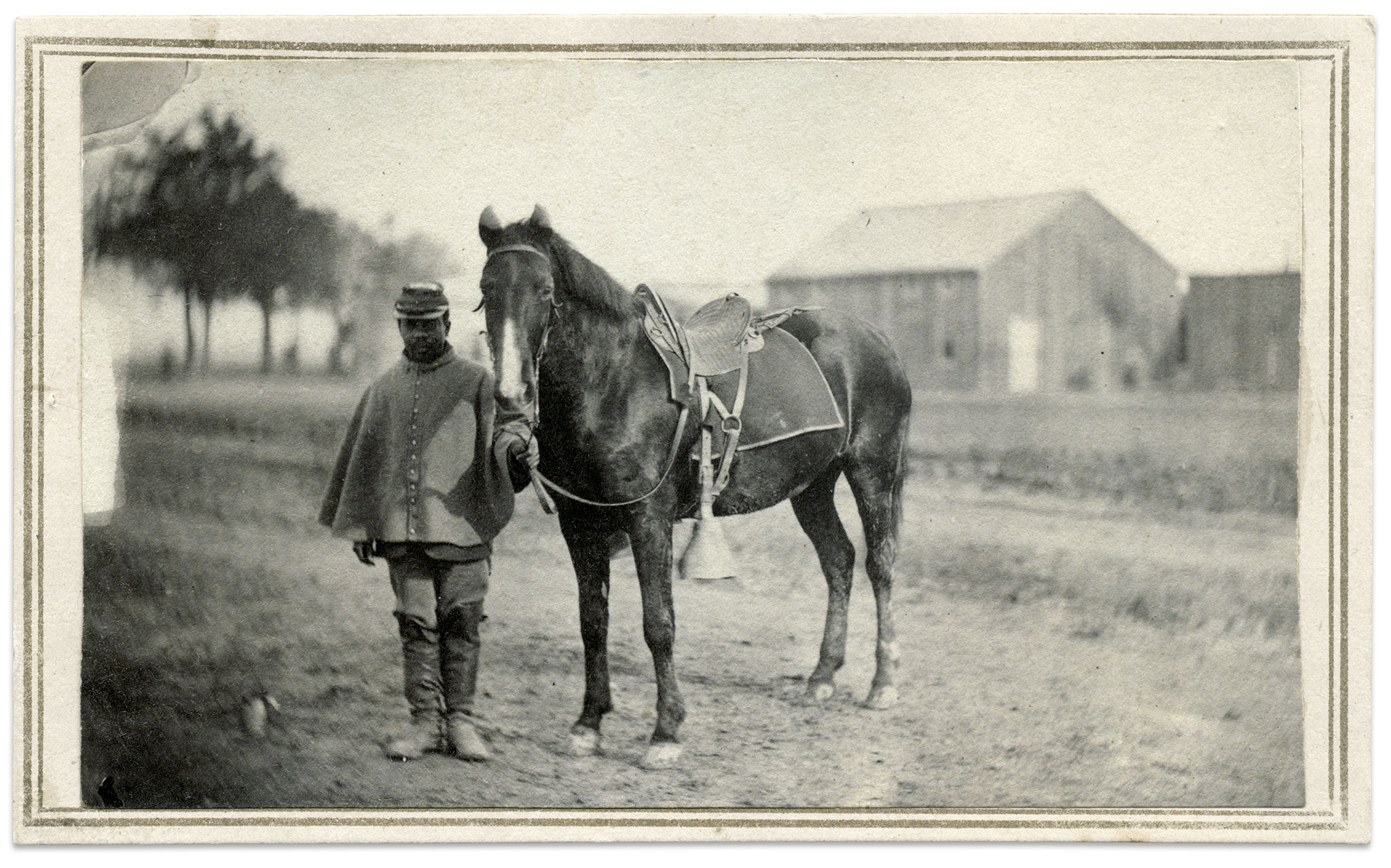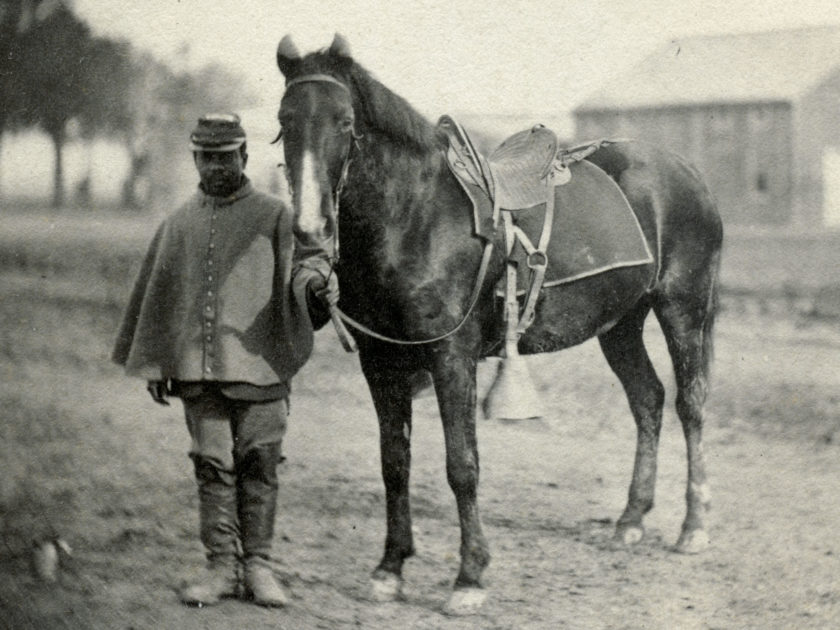By J. Matthew Gallman
When we attempt to understand history, we often find that empirical truths unfold alongside significant symbolic moments. And, to make things even more complicated, it is not at all unusual that our collective memory of events (both real and symbolic) differs from how participants understood what they were living through.
Let’s consider these large and abstract observations through the lens offered by the simple portrait of Pvt. Booth and his horse.

To start, there are some concrete truths. Members of the United States Colored Troops played an instrumental role in the Union’s military victory in the Civil War. And although black northern soldiers earned a level of respect for their battlefield heroics, African-American observers looking back on the war—from the distance of a generation or a century—might reasonably have felt that those patriotic sacrifices did not yield appropriate transformations in their lives. So much for the empirical.
The portrait of Pvt. Booth captured multiple symbolic truths in the midst of the Civil War. Consider three powerful symbols, all intertwined in this image.
First, we have Pvt. Booth the soldier. This picture records the historic fact that this African-American man served in the U.S. cavalry during the Civil War. This basic fact held tremendous symbolic importance. When the nation agreed to permit black men to serve in the military, a crucial symbolic barrier fell, even while we can—as objective historians—recognize that the initial offer of a blue uniform did not come with equal pay or treatment, or even comparable battlefield assignments.
Second, we have a host of symbols surrounding the act of photographic portraiture. Today, we think little of snapping a photograph. But in 1861, the world of portraiture was in rapid flux. Thanks to a series of technological innovations, small and inexpensive cartes de visite had become accessible to most Americans. We know that advertisements for portrait photographers appeared in African-American newspapers in the North. Emilie Davis, a black working class diarist living in wartime Philadelphia, repeatedly wrote about having her portrait made, and exchanging pictures with others. This picture illustrates the rapid democratization of portrait photography. Pvt. Booth would likely have had multiple copies of his portrait, which he might have shared with friends and loved ones. They, in turn, could have placed this photograph of a uniformed black man in their personal photograph albums, or perhaps displayed the image in their homes. These private rituals, in which black soldiers presented portraits to people in their communities, were no doubt repeated hundreds of times across the country.
These portraits represented something more than the fact that a black man had the opportunity to serve in uniform. Consider how Pvt. Booth and his horse posed. And then compare the image–and their poses–to the portraits of First Lieutenants Patrick T. Jackson Jr. and George F. Wilson, and 2nd Lt. Robert S. Oliver. Some members of the 5th Massachusetts Cavalry posed seated astride their mounts, while others–including Booth, Jackson, Wilson and Oliver–chose to stand by their horses. The backgrounds suggest that each man posed in the same location. Booth wore a great coat, probably over an enlisted man’s uniform. But the striking thing here is that, for the purposes of these portraits, it is impossible to discern any racial differences. On the day when these men had their portraits made, the camera saw no differences, and the photographer made no effort to construct some sort of separate–or even “separate but equal”—version of portraiture to capture Pvt. Booth and his horse. He was, quite simply, a U.S. cavalryman. This simple truth was perhaps not lost on the people who inserted his image and similar portraits of other USCT men into their albums.
“The portrait of Pvt. Booth captured multiple symbolic truths in the midst of the Civil War.”
When we speak of the cartes de visite of USCT infantrymen, the symbolic observations might end with the powerful fact that black men in blue uniforms posed very much like their white comrades. But Pvt. Booth was not an infantryman, but a member of the cavalry. This invites a third observation about wartime symbols.
It has been widely documented that across the Confederacy, from President Jefferson Davis on down to enlisted men, the decision to enlist black men represented a cultural affront to white southerners, and prompted threats of violent reprisals against black soldiers and their white officers. This profound fury combined racial hostility with a sense of gendered insult. That is, insofar as white southern men understood warfare as an honorable pursuit among gentlemen, the notion of facing black men—the embodiment of social and racial inferiority—constituted an insult to their masculinity.
If Confederate men perceived marching into battle as an inherently masculine action, riding into battle as officers or cavalrymen combined manhood and class in complex ways. White southerners connected the advanced skills of the horseman with broader masculine notions of honor. At the outset of the war, Confederate cavalrymen felt confident that they enjoyed an advantage over their northern counterparts. By mid-war, however, any gap in pure horsemanship had closed, but Confederate cavalrymen—in contrast with members of the U.S. cavalry—could still claim that those who rode into battle represented the economic and social elite. Confederate cavalrymen supplied their own horses, ensuring that the young men in their ranks generally came from the South’s more affluent families, and represented the pride of slaveholding society. At this point, the empirical and symbolic diverge just a bit. In truth, Pvt. Booth and his comrades in the 5th Massachusetts Cavalry probably never rode into battle against their white Confederate adversaries, although they did fight in several engagements as dismounted cavalry. But the North did put seven USCT Cavalry regiments into the field, with several performing valiantly in a number of engagements. When Pvt. Booth and his black comrades joined the ranks of the Union cavalry, they presented a marked challenge to the very core of white southern manhood.
That symbolic change is also apparent in this remarkable portrait.
J. Matthew Gallman is Professor of History at the University of Florida. He is the author or editor of ten books, including Defining Duty in the Civil War: Personal Choice, Popular Culture, and the Union Home Front (UNC, 2015) and—coedited with Gary Gallagher—The Lens of War: Historians Reflect on their Favorite Civil War Photographs (Georgia, 2015).
SPREAD THE WORD: We encourage you to share this story on social media and elsewhere to educate and raise awareness. If you wish to use any image on this page for another purpose, please request permission.
LEARN MORE about Military Images, America’s only magazine dedicated to showcasing, interpreting and preserving Civil War portrait photography.
VISIT OUR STORE to subscribe, renew a subscription, and more.

